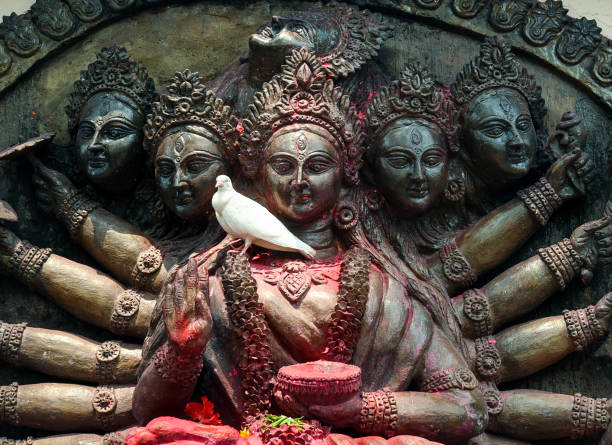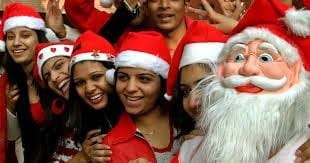Ask the masses of India about Ambaji Maata, and they’ll know. Ask people about Vaishno Devi, and they will know. But ask them about Kamakhya Maata and very few, apart from the devotees, would know about her.
Who is Kamakhya Maata and what is the Kamakhya Mandir? We’ll delve into that. But more importantly, why are we talking about her? What is so significant about her?
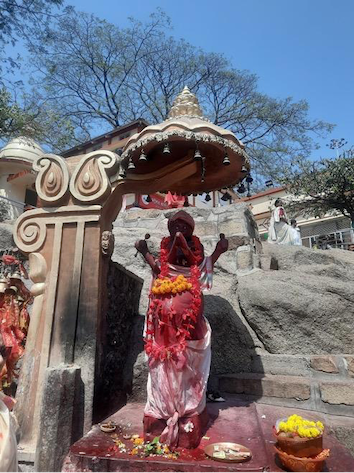
In a country where people call it ‘that time of the month’, where advertisements prefer to show period blood as blue, the menstrual cycle is a topic that is still not candidly spoken about in public. But, Indians being Indians, we leave no chance to keep it ironic with our contradictory behaviour at all times: some we may like, and some not. The reason behind worshipping Kamakhya Maata is one such event that enthralls you and makes you fall in love with the legends of Kamakhya Mandir.
The main shrine of Kamakhya Maata, also known as the ‘Bleeding Goddess’ or the ‘Goddess of Desire’, is installed in the middle chamber of the temple. The main shrine is not an idol but the vulva or yoni (in Sanskrit) of Goddess Sati. Pilgrims file solemnly into a tiny alleyway called the sanctum sanctorum, climb several flights of stairs in the alleyway, and find themselves by a tiny pool of spring water. Pilgrims squat by the edge of the pool and pray to the symbolic yoni organ covered with a red cloth. This red cloth is distributed among the devotees as prasad once a year.
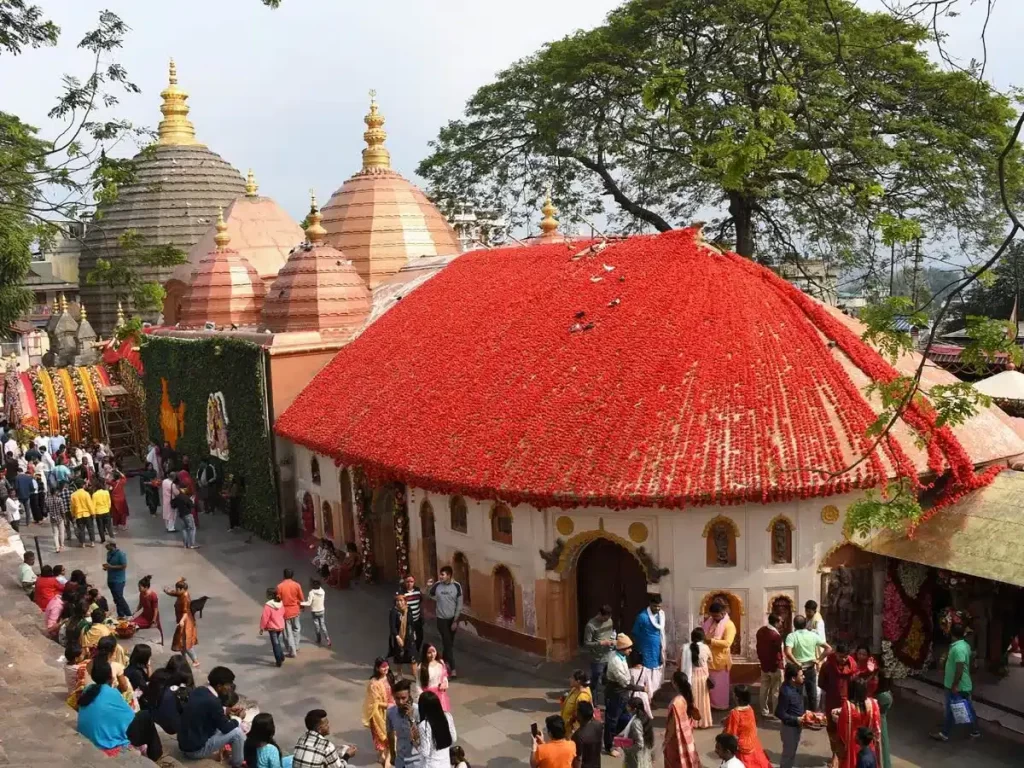
To understand all of it better, let us start from the beginning.
The temple, Kamakhya Mandir, is located atop the Nilachal Hill in the western part of Guwahati, the capital city of Assam, India. It remains one of the most mythologically potent and religiously charged locus of devotion for millions of Hindus nationwide. The temple is the earliest of the 51 Shakti Peethas. In Sanskrit, ‘Kama’ means to love or desire, and ‘akhya’ means to be renowned. A tantric text, Kalikapurana, explains the reasoning behind her name. It states that Shiva speaks:
“As the Goddess has come to the great mountain Nilakuta (Nilachala) to enjoy making love with me (Shiva), she is called the Goddess Kamakhya (renowned Goddess of Desire), who resides there in secret.
Since she gives love, is a loving female, is the embodiment of love, the beloved, she restores the limbs of Kama and destroys the limbs of Kama; she is called Kamakhya.”
Speaking of the origin of her name, we cannot overlook the Khasi and Garo tribe’s relation to the same. The popular Khasi(a matriarchal tribe) legend says that the Kamakhya temple was established by the Khasi in ancient times when it was under their control. The Sanskrit name: Kamakhya is a corruption of the Khasi word ‘Ka-mei-kha’ meaning ‘the old woman of Khasi race’. On the other hand, the Garo believe the word Kamakhya is from the Garo word ‘kama’ meaning ‘form of greeting’ and ‘akhye’ meaning ‘mother’. They believe that the goddess was brought to the Khasi. They moved the image from their settlement to the current location.
The location of the temple brings out another riveting myth. Mythological legends state that Sati married Lord Shiva against the will of her father, King Daksha. The king was arranging a massive yajna (a special ritual practiced in Indian tradition) in his kingdom one day. He did not ask for the presence of Sati and Shiva. Despite that, Sati became determined to visit her father’s kingdom to worship via the yajna. Shiva had tried convincing Sati to refrain from attending the yajna but in vain. Upon her arrival, her father insulted her because he wanted her to marry another person. Her father even went to the extent of insulting Lord Shiva, which infuriated Sati; she burned off the yajna with her anger and, subsequently, killed herself by jumping into the yajna fire. Shiva got immensely angry. He took her dead body onto his shoulder and began to wander the entire universe. He performed Tandav — the dance of the destruction of the universe — in rage. To calm Shiva down and to save the universe from destruction, Lord Vishnu cut Sati’s dead body with his Sudarshan chakra into several pieces, and her body parts fell into 51 different parts of the earth. These places came to be known as the 51 Shakti Peeths. The genitals and womb (yoni) of Sati fell at the place where the Kamakhya Mandir now stands. Until later, the place of their fall was unknown. It was Kamdev, the god of love, who went to search for it. On his way, he worshiped to get rid of the curse given by Brahma. When he finally found out about the Yoni, he got rid of the curse. Following this the place came to be known as Kamakhya.

The temple was first built in the eighth century and later went on to be rebuilt several times. It was destroyed during the mid-decades of the second millennium, and the revised temple structure was built in 1565 by Chilarai of the Koch dynasty, a style typical of medieval Assam temples. The Nilachal style of architecture is another form of indigenous type of temple architecture that originated from the Nilachal Hills, and is similar to the Nagara style of temple architecture. The temple consists of four chambers: garbhagriha and three mandapas locally called calanta, pancaratna, and natamandira. Narrow, steep stone steps lead one to the small and dark garbhagriha. Inside the cave, a sheet of stone slopes downwards from both sides meeting in a yoni-like depression some ten inches deep. The hollow is always full of water from an underground perennial spring. As mentioned earlier, it is the stone (symbolizing the yoni) in the vulva-shaped depression that is worshipped and is considered the paramount peetha (abode) of the devi. The garbhaghrihas of the other temples in the Kamakhya complex follow the same structure: yoni-shaped stone filled with water and situated below ground level. There is no image or idol of Kamakhya Maata here. This vulva-shaped stone is over which a natural spring keeps running.
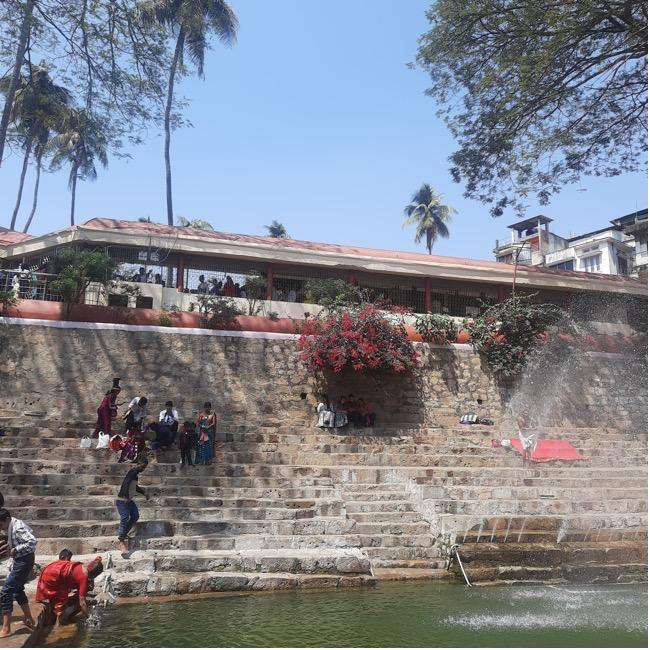
During the 10th to 12th centuries, Kamakhya became a renowned centre of tantric sacrifices and worship. Kamakhya was the most important centre for tantric and cults during the Pala dynasty. Panchamakara (the five most dynamic and high-powered modes in Tantric practice) is still the principal mode of worship at the temple. The panchamakara consists of Mamsa (flesh), Matsya (fish), Mudra (parched grain), Madya (wine), and Maithun (ritual sex). A buffalo is sacrificed every day to be presented to the Goddess Kali. The sacrifices are made in the inner sanctum of the temple. The top of the temple is in line with the general structure of other temples found in the Kamakhya complex. The main temple, consisting of seven hoksha, was built in Assam-type architecture in the later period. The temple has a hemispherical shikhara (dome), a beehive-like structure, characteristic of lower Assam. The temple walls contain sculpted images of bejewelled human figures, the pantheon of gods, and an inscription, the largest among the Barpeta inscriptions, from the ruins at Ratnapitha.
The main temple consists of three prime chambers. The western chamber is a large, rectangular hall which serves as a dance hall during festivals. It was also home to the natmandir (for traditional folk dance and music performances based on sukti temples); it was added to the complex in 1759 AD by the Ahom king Rajeswar Singha. The middle chamber is a square with a small idol of the Goddess Sati. The structure is attributed to the early 18th century. The temple door is made of gold. Above it is a golden image of the sun and the moon hanging on the ceiling. The second chamber leads to the sanctum sanctorum of the temple, which is in the form of a cave; this is where the yoni lies. To get to visit and offer prayers to the yoni is arduous and requires pilgrims to stand in queues for more than eighteen hours most of the time.

The main event or annual festival of the Kamakhya Mandir is the Ambucha Mela. It coincides with Shravan, usually around the middle of June. Following the fact that Kamakhya Mandir is a centre for Tantric Shaktism too, many tantric babas who live in strict seclusion for almost an entire year turn up during the Ambucha mela. The festival relates to a significant legend, according to which, in this month, the goddess Kamakhya undergoes her annual menstrual cycle. The festival may last four days and the temple complex is closed for the first three days with rituals done within the temple. The door opens on the fourth day. The legend holds that the rituals restore the purity of the devi after she experienced her menses cycle. After the first burst of monsoon, the festival celebration commences. The Brahmaputra river water turns red and symbolises the menstrual blood of Kamakhya Maata.
Scientifically, the soil is naturally rich in iron content, which is why the Brahmaputra river water looks blood red. The second possible reason could be the presence of the shrine of Goddess Kamakhya in the mountains. The mountains have a significant deposit of Cinnabar, a strange compound of mercury sulfide. The rocks collected from the Kamakhya Temple are sold in the form of Kamiya Sindoor. People claim that this vermilion has the power to control the minds of people. Thus it is known as Vashikaran Sindoor. However, the amount of soil present is inadequate to make the river as blood-red as it becomes. And we are still in the dark as to why the Brahmaputra River turns red on only the three days of June. Devotees call it the magic of the Goddess Kamakhya. The prasad is distributed in two forms, namely Angodak and Angabastra. Angodak means the fluid part of the body-spring (or reproductive fluid). Angabastra means a strip of red skin that covers the yoni stone through menstrual days. Every year lakhs of pilgrims – from sadhus to householders – from all corners of the country come to Guwahati to celebrate this festival. The only people who do not go to the temple are the descendants of the medieval Koch royalty, who had rebuilt Kamakhaya temple in 1565, as the Goddess, according to the legend, cursed the king and his brother Chilarai, when they secretly peeped at her dance.

The narrative associated with the celebration of Ambubachi Mela is to strengthen womanhood and her tendency to bring new life into existence at the time she menstruates. Maa Kamakhaya’s legend, essentially, celebrates the ‘Shakti’ in a woman. This worship of Kamakhya Maata preaches the eternal process of cosmic creation, destruction, and rebirth per Hindu cosmology. When we look more closely at the various mythological stories about Kamakhya Maata and her temple, we can peel back to see that they are full of symbolism that helps us to understand the power dynamics between men and women, divine power and human empowerment. It also enlightens our sense of spiritualism and physical realities. One seeks Kamakhya Maata’s blessings for prosperity, fertility, and the power of creation.
Whether one believes in her or not, the legend of Kamakhya Maata is an empowering and emancipating one. Many such beliefs within India give people the power to create a vision and strengthen their will. Maa Kamakhya, the yielder of all desires, possesses the divine feminine energy that many women of our country aspire to have. The worship of Maa Kamakhya is one irony of India that leaves you intrigued and with a deep feeling of reverence.
Written by Shivaanshi Singh
Edited by Helee Thaker

